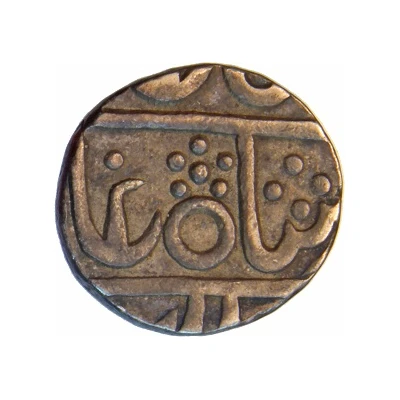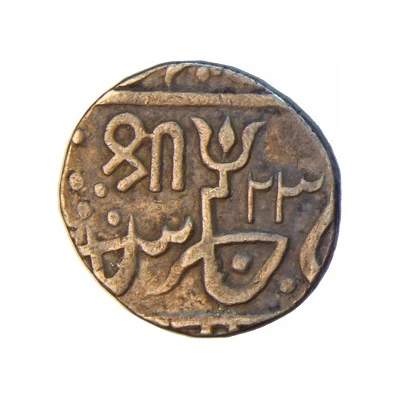


© Sujit
Rupee - Baija Bai ND
| Silver | 10.8 g | 22 mm |
| Issuer | Princely state of Gwalior (Indian princely states) |
|---|---|
| Regent | Baiza Bai (1827-1833) |
| Type | Standard circulation coin |
| Years | 1827-1833 |
| Value | 1 Rupee |
| Currency | Rupee |
| Composition | Silver |
| Weight | 10.8 g |
| Diameter | 22 mm |
| Shape | Round |
| Demonetized | Yes |
| Updated | 2024-10-05 |
| Numista | N#77344 |
|---|---|
| Rarity index | 93% |
Reverse
Legend, with sri and trident of Baija Bao, mintname Lashkar off flan
Lettering:
श्री
۲۳
Translation:
Sri
RY 23
Edge
Plain
Comment
Weight varies 10.70-11.60 grams.From coinindia.com: Baija Bao was the wife of Daulat Rao. When Daulat Rao died in 1827, he left no son, so Baija Bao adopted a distant scion of the family, who became Jankoji Rao II. However, at the time of his adoption, Jankoji was only 11 years old, so Baija Bao ruled in his place until he was old enough to take the throne.
Interesting fact
One interesting fact about the Baija Bai ND (1827-1833) Rupee coin from the Princely state of Gwalior is that it was made of silver, which was a significant departure from the usual copper or bronze used in the production of Indian coins at that time. This decision to use silver was likely influenced by the state's economic and political ties with the British East India Company, which had a strong presence in the region. The use of silver in the coin's production not only added to its value but also made it more durable and resistant to wear and tear, making it a unique and interesting piece in the history of Indian numismatics.
![1 Rupee - Muhammad Akbar II [Baija Bai] ND front](/storage/images/1-Rupee-Muhammad-Akbar-II-Baija-Bai_111588_1.webp)
![1 Rupee - Muhammad Akbar II [Baija Bai] ND back](/storage/images/1-Rupee-Muhammad-Akbar-II-Baija-Bai_111588_2.webp)
![1 Rupee - Muhammad Akbar II [Jankoji Rao] front](/storage/images/1-Rupee-Muhammad-Akbar-II-Jankoji-Rao_139699_1.webp)
![1 Rupee - Muhammad Akbar II [Jankoji Rao] back](/storage/images/1-Rupee-Muhammad-Akbar-II-Jankoji-Rao_139699_2.webp)